Summer Season Water Temperature Modeling under the Climate Change: Case Study for Fourchue River, Quebec, Canada
Abstract
:1. Introduction
2. Study Area and Data
2.1. Study Area and Observed Data
2.2. Climate Change Projection
3. Methodology
3.1. Water Temperature Model: CEQUEAU Model
3.2. Climate Change Projection: Climate Scenario and Model
3.3. Quantile Mapping
4. Result and Discussion
4.1. Water Temperature Modeling
4.2. Meteorological Predictor Estimation under Climate Change
4.3. Future Water Temperature Simulation
5. Conclusions
- (1)
- As shown by the water temperature results of the CEQUEAU model simulations for the future period, it is possible that the median water temperature in June will increase 0.2–0.7 °C and that, in September, median water temperature could decrease by 0.2–1.1 °C, The rise in water temperature in June may be favorable to brook trout growth, as temperatures will be near or exceeding the optimal growth range (16.0 °C). However, several days over UILT (24.9 °C) for brook trout are also likely to occur, according to different scenarios.
- (2)
- The change of water temperature in summer season will affect the overall conditions of the aquatic ecosystem and its related environment and industries. Therefore, flow regulation procedures, including cold water releases from the Morin dam, may have to be considered to mitigate the negative effects of more extreme temperature occurrences on the Fourchue River.
Supplementary Materials
Acknowledgments
Author Contributions
Conflicts of Interest
References
- Coutant, C.C. Perspective on Temperature in the Pacific Northwest’s Fresh Water (No. ORNL/TM-1999/44); Oak Ridge National Laboratory: Oak Ridge, TN, USA, 1999. [Google Scholar] [CrossRef]
- Nunn, A.D.; Cowx, I.G.; Frear, P.A.; Harvey, J.P. Is water temperature an adequate predictor of recruitment success in cyprinid fish populations in lowland rivers? Freshw. Biol. 2003, 48, 579–588. [Google Scholar] [CrossRef]
- Coulter, D.P. Consequences of Short-Term Water Temperature Variability to Fish: Current and Future Climate Change Impacts. Ph.D. Thesis, Purdue University, West Lafayette, IN, USA, 2015. [Google Scholar]
- Sloat, M.R.; Shepard, B.B.; White, R.G.; Carson, S. Influence of stream temperature on the spatial distribution of west slope cutthroat trout growth potential within the Madison river basin, Montana. N. Am. J. Fish. Manag. 2005, 25, 225–237. [Google Scholar] [CrossRef]
- Handeland, S.O.; Imsland, A.K.; Stefansson, S.O. The effect of temperature and fish size on growth, feed intake, food conversion efficiency and stomach evacuation rate of Atlantic salmon post-smolts. Aquaculture 2008, 283, 36–42. [Google Scholar] [CrossRef]
- Besson, M.; Vandeputte, M.; van Arendonk, J.A.M.; Aubin, J.; de Boer, I.J.M.; Quillet, E.; Komen, H. Influence of water temperature on the economic value of growth rate in fish farming: the case of sea bass (Dicentrarchus labrax) cage farming in the Mediterranean. Aquaculture 2016, 462, 47–55. [Google Scholar] [CrossRef]
- Shrestha, S.; Kazama, F. Assessment of surface water quality using multivariate statistical techniques: A case study of the Fuji river basin. Jpn. Environ. Model. Softw. 2007, 22, 464–475. [Google Scholar] [CrossRef]
- Chang, H. Spatial analysis of water quality trends in the Han river basin, South Korea. Water Res. 2008, 42, 3285–3304. [Google Scholar] [CrossRef] [PubMed]
- Goniea, T.M.; Keefer, M.L.; Bjornn, T.C.; Peery, C.A.; Bennett, D.H.; Stuehrenberg, L.C. Behavioral thermoregulation and slowed migration by adult fall chinook salmon in response to high Columbia river water temperatures. Trans. Am. Fish. Soc. 2006, 135, 408–419. [Google Scholar] [CrossRef]
- Isaak, D.J.; Luce, C.H.; Rieman, B.E.; Nagel, D.E.; Peterson, E.E.; Horan, D.L.; Parkes, S.; Chandler, G.L. Effects of climate change and wildfire on stream temperatures and salmonid thermal habitat in a mountain river network. Ecol. Appl. 2010, 20, 1350–1371. [Google Scholar] [CrossRef] [PubMed]
- Parra, I.; Almodóvar, A.; Ayllón, D.; Nicola, G.G.; Elvira, B. Unravelling the effects of water temperature and density dependence on the spatial variation of brown trout (Salmo trutta) body size. Can. J. Fish. Aquat. Sci. 2012, 69, 821–832. [Google Scholar] [CrossRef]
- Lahnsteiner, F. Thermotolerance of Brown Trout, Salmo Trutta, Gametes and embryos to increased water temperatures. J. Appl. Ichthyol. 2012, 28, 745–751. [Google Scholar] [CrossRef]
- Matthews, K. California Golden Trout: Can their warming streams handle other stressors? Procedings of the 144th Annual Meeting of the American Fisheries Society (AFS), Quebec, QC, Canada, 17–21 August 2014. [Google Scholar]
- Bouck, G.R.; Chapman, G.A.; Schneider, P.W.; Stevens, D.G. Effects of holding temperatures on reproductive development in adult sockeye salmon (Oncorhynchus Nerka). In Proceedings of the 26th Annual Northwest Fish Culture Conference, Centralia, WA, USA, 6–7 December 1975. [Google Scholar]
- Poff, N.L.; Brinson, M.M.; Day, J.W. Aquatic Ecosystems and Global Climate Change; Pew Center on Global Climate Change: Arlington, VA, USA, 2002. [Google Scholar]
- Reist, J.D.; Wrona, F.J.; Prowse, T.D.; Power, M.; Dempson, J.B.; Beamish, R.J.; Sawatzky, C.D. General effects of climate change on arctic fishes and fish populations. AMBIO J. Hum. Environ. 2006, 35, 370–380. [Google Scholar] [CrossRef]
- Bärlocher, F.; Seena, S.; Wilson, K.P.; Dudley Williams, D. Raised water temperature lowers diversity of hyporheic aquatic hyphomycetes. Freshw. Biol. 2008, 53, 368–379. [Google Scholar] [CrossRef]
- Wenger, S.J.; Isaak, D.J.; Luce, C.H.; Neville, H.M.; Fausch, K.D.; Dunham, J.B.; Dauwalter, D.C.; Young, M.K.; Elsner, M.M.; Rieman, B.E.; et al. Flow regime, temperature, and biotic interactions drive differential declines of trout species under climate change. Proc. Natl. Acad. Sci. USA 2011, 108, 14175–14180. [Google Scholar] [CrossRef] [PubMed]
- Trumpickas, J.; Shuter, B.J.; Minns, C.K.; Cyr, H. Characterizing patterns of nearshore water temperature variation in the North American Great Lakes and assessing sensitivities to climate change. J. Gt. Lakes Res. 2015, 41, 53–64. [Google Scholar] [CrossRef]
- Kaushal, S.S.; Likens, G.E.; Jaworski, N.A.; Pace, M.L.; Sides, A.M.; Seekell, D.; Belt, K.T.; Secor, D.H.; Wingate, R.L. Rising stream and river temperatures in the United States. Front. Ecol. Environ. 2010, 8, 461–466. [Google Scholar] [CrossRef]
- Van Vliet, M.T.; Franssen, W.H.; Yearsley, J.R.; Ludwig, F.; Haddeland, I.; Lettenmaier, D.P.; Kabat, P. Global river discharge and water temperature under climate change. Glob. Environ. Chang. 2013, 23, 450–464. [Google Scholar] [CrossRef]
- Hunt, G.L.; Stabeno, P.J. Climate change and the control of energy flow in the southeastern Bering Sea. Prog. Oceanogr. 2002, 55, 5–22. [Google Scholar] [CrossRef]
- Gille, S.T. Decadal-scale temperature trends in the Southern Hemisphere Ocean. J. Clim. 2008, 21, 4749–4765. [Google Scholar] [CrossRef]
- Brown, A. Biodiversity: Stream temperature velocity. Nat. Clim. Chang. 2016, 6, 440. [Google Scholar] [CrossRef]
- Morrison, J.; Quick, M.C.; Foreman, M.G. Climate change in the Fraser River watershed: Flow and temperature projections. J. Hydrol. 2002, 263, 230–244. [Google Scholar] [CrossRef]
- Ferrari, M.R.; Miller, J.R.; Russell, G.L. Modeling changes in summer temperature of the Fraser River during the next century. J. Hydrol. 2007, 342, 336–346. [Google Scholar] [CrossRef]
- Fang, X.; Stefan, H.G. Projections of climate change effects on water temperature characteristics of small lakes in the contiguous US. Clim. Chang. 1999, 42, 377–412. [Google Scholar] [CrossRef]
- Quayle, W.C.; Peck, L.S.; Peat, H.; Ellis-Evans, J.C.; Harrigan, P.R. Extreme responses to climate change in Antarctic lakes. Science 2002, 295, 645. [Google Scholar] [CrossRef] [PubMed]
- Mann, M.E.; Zhang, Z.; Hughes, M.K.; Bradley, R.S.; Miller, S.K.; Rutherford, S.; Ni, F. Proxy-based reconstructions of hemispheric and global surface temperature variations over the past two millennia. Proc. Natl. Acad. Sci. USA 2008, 105, 13252–13257. [Google Scholar] [CrossRef] [PubMed]
- Hansen, J.; Ruedy, R.; Sato, M.; Lo, K. Global surface temperature change. Rev. Geophys. 2010, 48, RG4004. [Google Scholar] [CrossRef]
- Islam, M.N.; Bhuyain, M.A.B.; Mannan, M.A.; Hossain, M.I.; Ali, M.L. Study on environmental implications and its impact on aquatic productivity in the Southwest coastal region. J. Environ. Sci. Nat. Resour. 2015, 6, 71–78. [Google Scholar] [CrossRef]
- Munroe, D.M.; Narváez, D.A.; Hennen, D.; Jacobson, L.; Mann, R.; Hofmann, E.E.; Klinck, J.M. Fishing and bottom water temperature as drivers of change in maximum shell length in Atlantic surfclams (Spisula solidissima). Estuar. Coast. Shelf Sci. 2016, 170, 112–122. [Google Scholar] [CrossRef]
- Thompson, P.L.; Shurin, J.B. Regional zooplankton biodiversity provides limited buffering of pond ecosystems against climate change. J. Anim. Ecol. 2012, 81, 251–259. [Google Scholar] [CrossRef] [PubMed]
- Johnson, R.K.; Almlöf, K. Adapting boreal streams to climate change: effects of riparian vegetation on water temperature and biological assemblages. Freshw. Sci. 2016, 35, 984–997. [Google Scholar] [CrossRef]
- Santiago, J.M.; García de Jalón, D.; Alonso, C.; Solana, J.; Ribalaygua, J.; Pórtoles, J.; Monjo, R. Brown trout thermal niche and climate change: Expected changes in the distribution of cold-water fish in central Spain. Ecohydrology 2015, 9, 514–528. [Google Scholar] [CrossRef]
- Selbig, W.R. Simulating the effect of climate change on stream temperature in the Trout Lake Watershed, Wisconsin. Sci. Total Environ. 2015, 521, 11–18. [Google Scholar] [CrossRef] [PubMed]
- Al-Chokhachy, R.; Schmetterling, D.A.; Clancy, C.; Saffel, P.; Kovach, R.P.; Nyce, L.G.; Pierce, R. Are brown trout replacing or displacing bull trout populations in a changing climate? Can. J. Fish. Aquat. Sci. 2016, 73, 1395–1404. [Google Scholar] [CrossRef]
- Moss, R.; Babiker, M.; Brinkman, S.; Calvo, E.; Carter, T.R.; Edmonds, J.; Elgizouli, I.; Emori, S.; Erda, L.; Hibbard, K.; et al. Towards New Scenarios for Analysis of Emissions, Climate Change, Impacts, and Response Strategies: IPCC Expert Meeting Report; IPCC Secretariat: Geneva, Switzerland, 2008. [Google Scholar]
- Beaupré, L. Comparaison de Modèles Thermiques Statistique et Déterministe Pour L’estimation D’indices Thermiques sur les Portions Aménagées et Naturelles de la Rivière Fourchue. Master’s Thesis, INRS-ETE, Quebec, QC, Canada, 2014. [Google Scholar]
- Kwak, J.; St-Hilaire, A.; Chebana, F. A comparative study for water temperature modelling in a small basin, the Fourchue River, Quebec, Canada. Hydrol. Sci. J. 2016, 62, 64–75. [Google Scholar] [CrossRef]
- Bartholow, J.M. The Stream Network Temperature Model (SNTEMP): A Decade of Results. In Workshop on Computer Application in Water Management; GPAC Publication: Fort Collins, CO, USA, 1995. [Google Scholar]
- Guillemette, N.; St-Hilaire, A.; Ouarda, T.B.M.J.; Bergeron, N.; Robichaud, E.; Bilodeau, L. Feasibility study of a geostatistical model of monthly maximum stream temperatures in a multivariate space. J. Hydrol. 2009, 364, 1–12. [Google Scholar] [CrossRef]
- Morin, G.; Sochanski, W.; Paquet, P. Le mode`le de simulation de quantite´ CEQUEAU-ONU, Manuel de re´fe´rences. J. Vasc. Interv. Radiol. 1998, 22, S514. [Google Scholar]
- Diaconescu, E. The use of NARX neural networks to predict chaotic time series. WSEAS Trans. Comput. Res. 2008, 3, 182–191. [Google Scholar]
- Diversi, R.; Guidorzi, R.; Soverini, U. Identification of ARMAX models with noisy input and output. IFAC Proc. Vol. 2011, 18, 13121–13126. [Google Scholar] [CrossRef]
- Knutti, R.; Sedláček, J. Robustness and uncertainties in the new CMIP5 climate model projections. Nat. Clim. Chang. 2013, 3, 369–373. [Google Scholar] [CrossRef]
- St-Hilaire, A.; El-Jabi, N.; Caissie, D.; Morin, G. Sensitivity analysis of a deterministic water temperature model to forest canopy and soil temperature in Catamaran Brook (New Brunswick, Canada). Hydrol. Proc. 2003, 17, 2033–2047. [Google Scholar] [CrossRef]
- Seiller, G.; Anctil, F. Climate change impacts on the hydrologic regime of a Canadian river: comparing uncertainties arising from climate natural variability and lumped hydrological model structures. Hydrol. Earth Syst. Sci. 2014, 18, 2033–2047. [Google Scholar] [CrossRef]
- Morin, G.; Fortin, J.P.; Lardeau, J.P.; Sochanska, W.; Paquette, S. Mode`le CEQUEAU: Manuel D’utilisation; INRS-Eau, Ste-Foy: Quebec, QC, Canada, 1981. [Google Scholar]
- Sillmann, J.; Kharin, V.V.; Zhang, X.; Zwiers, F.W.; Bronaugh, D. Climate extremes indices in the CMIP5 multimodel ensemble: Part 1. Model evaluation in the present climate. J. Geophys. Res. Atmos. 2013, 118, 1716–1733. [Google Scholar] [CrossRef]
- Wood, A.W.; Maurer, E.P.; Kumar, A.; Lettenmaier, D.P. Long-range experimental hydrologic forecasting for the eastern United States. J. Geophys. Res. Atmos. 2002, 107, ACL 6-1–ACL 6-15. [Google Scholar] [CrossRef]
- Maurer, E.P.; Hidalgo, H.G.; Das, T.; Dettinger, M.D.; Cayan, D.R. The utility of daily large-scale climate data in the assessment of climate change impacts on daily streamflow in California. Hydrol. Earth Syst. Sci. 2010, 14, 1125–1138. [Google Scholar] [CrossRef]
- Trenberth, K.E.; Houghton, J.T.; Meira Filho, L.G. The Climate System: An Overview; Cambridge University Press: New York, NY, USA, 1996. [Google Scholar]
- Intergovernmental Panel on Climate Change. Table SPM-2. In Summary for Policy Makers; IPCC AR5 WG12013; IPCC: Geneva, Switzerland, 16 July 2014. [Google Scholar]
- Meinshausen, M.; Smith, S.J.; Calvin, K.; Daniel, J.S.; Kainuma, M.L.T.; Lamarque, J.-F.; Matsumoto, K.; Montzka, S.A.; Raper, S.C.B.; Riahi, K.; et al. The RCP greenhouse gas concentrations and their extensions from 1765 to 2300. Clim. Chang. 2011, 109, 213–241. [Google Scholar] [CrossRef]
- Pacific Climate Impacts Consortium. Available online: https://pacificclimate.org/ (assessed on 12 August 2016).
- Program for Climate Model Diagnosis and Intercomparison. Available online: http://www-pcmdi.llnl.gov/ (accessed on 5 October 2016).
- Gudmundsson, L.; Bremnes, J.B.; Haugen, J.E.; Engen-Skaugen, T. Technical Note: Downscaling RCM precipitation to the station scale using statistical transformations–a comparison of methods. Hydrol. Earth Syst. Sci. 2012, 16, 3383–3390. [Google Scholar] [CrossRef]
- Kyoung, M.S.; Kim, H.S.; Sivakumar, B.; Singh, V.P.; Ahn, K.S. Dynamic characteristics of monthly rainfall in the Korean Peninsula under climate change. Stoch. Environ. Res. Risk Assess. 2011, 25, 613–625. [Google Scholar] [CrossRef]
- Hyndman, R.J.; Khandakar, Y. Automatic time Series for Forecasting: The Forecast Package for R (No. 6/07); Department of Econometrics and Business Statistics, Monash University: Melbourne, Victoria, Australia, 2007. [Google Scholar]
- Nash, J.E.; Sutcliffe, J. V River flow forecasting through conceptual models part I—A discussion of principles. J. Hydrol. 1970, 10, 282–290. [Google Scholar] [CrossRef]
- Moriasi, D.N.; Arnold, J.G.; Van Liew, M.W.; Bingner, R.L.; Harmel, R.D.; Veith, T.L. Model evaluation guidelines for systematic quantification of accuracy in watershed simulations. Trans. ASABE 2007, 50, 885–900. [Google Scholar] [CrossRef]
- Pearson, E.S.; Hartley, H.O. Biometrika Tables for Statisticians; Cambridge University Press: Cambridge, UK, 1972; Volume 2. [Google Scholar]
- Barrow, E.; Maxwell, B.; Gachon, P. Climate Variability and Change in Canada. Past, Present and Future; Meteorological Service of Canada, Environment Canada: Toronto, ON, Canada, 2004. [Google Scholar]
- Dwyer, W.P.; Piper, R.G.; Smith, C.E. Brook trout growth efficiency as affected by temperature. Progress. Fish-Cultur. 1983, 45, 161–163. [Google Scholar] [CrossRef]
- Myrick, C.A.; Cech, J.J. Temperature influences on Californian rainbow trout physiological performance. Fish Physiol. Biochem. 2000, 22, 245–254. [Google Scholar] [CrossRef]
- Eaton, J.G.; Scheller, R.M. Effects of climate warming on fish thermal habitat in streams of the United States. Limnol. Oceanogr. 1996, 41, 1109–1115. [Google Scholar] [CrossRef]
- Fry, F.E.J. Effects of the Environment on Animal Activity; The University of Toronto Press: Toronto, ON, USA, 1947. [Google Scholar]
- Wismer, D.A.; Christie, A.E. Temperature Relationships of Great Lakes Fishes; Great Lakes Fishery Commission Special Publication: Ann Arbor, MI, USA, 1987. [Google Scholar]
- Caissie, D. The thermal regime of rivers: A review. Freshw. Biol. 2006, 51, 1389–1406. [Google Scholar] [CrossRef]

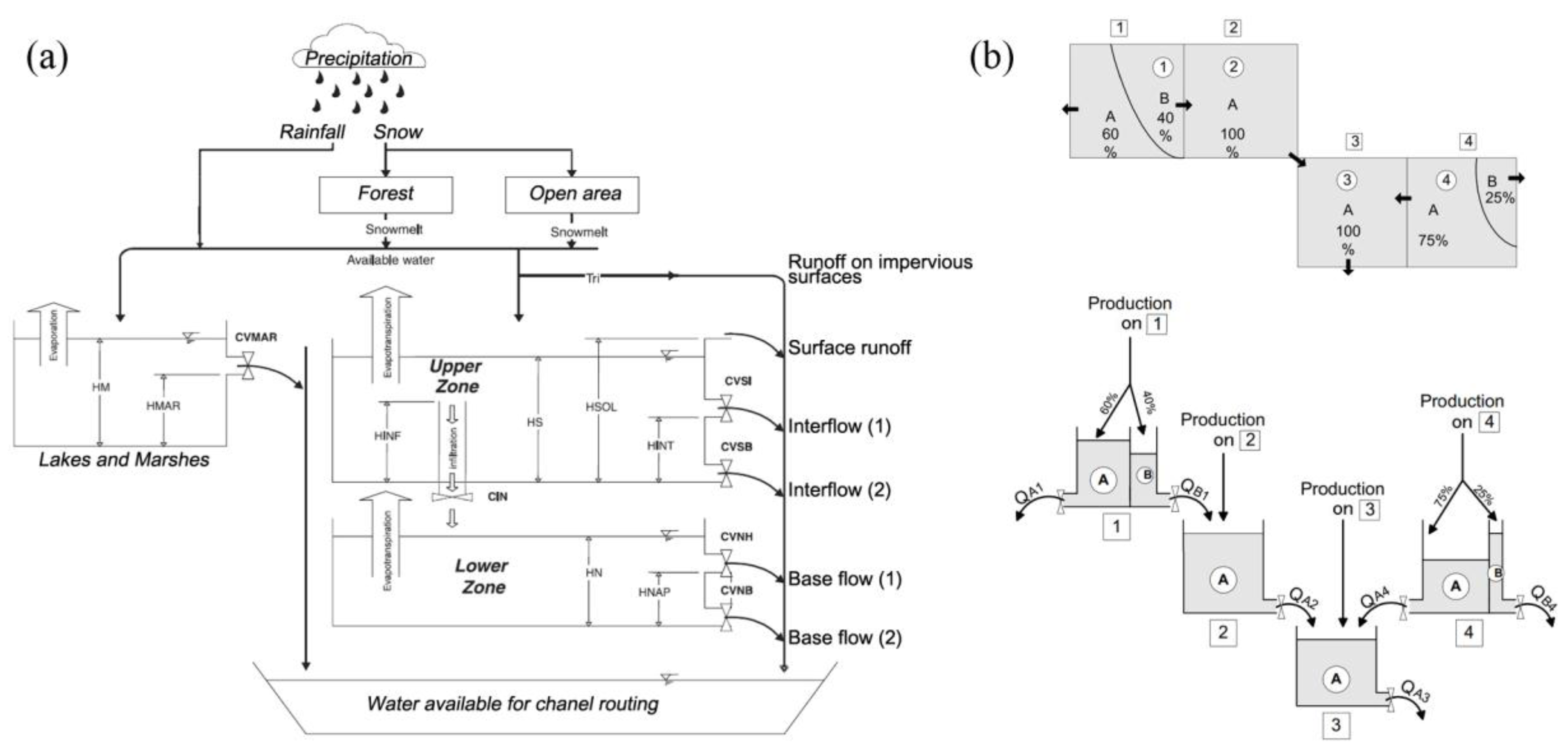
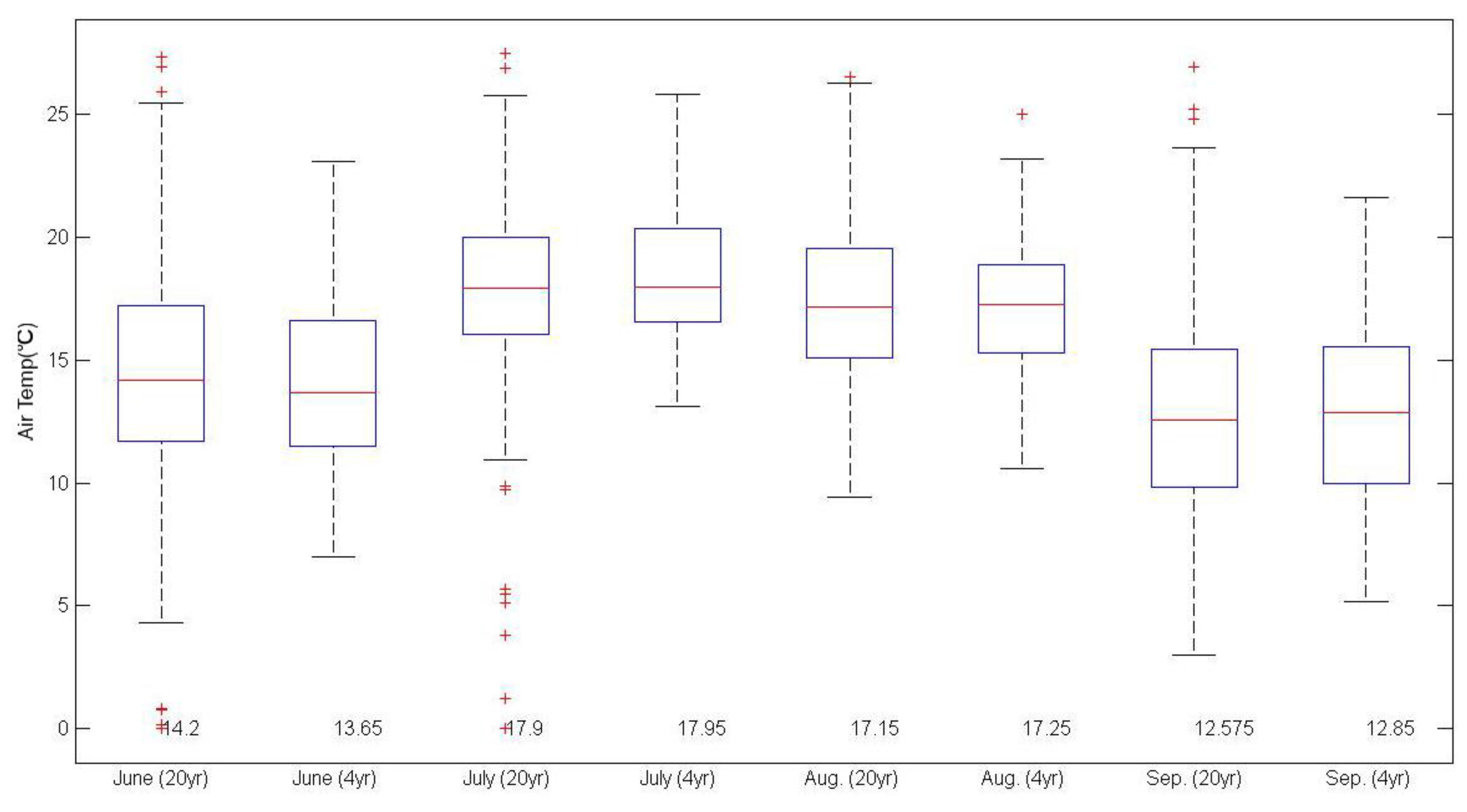
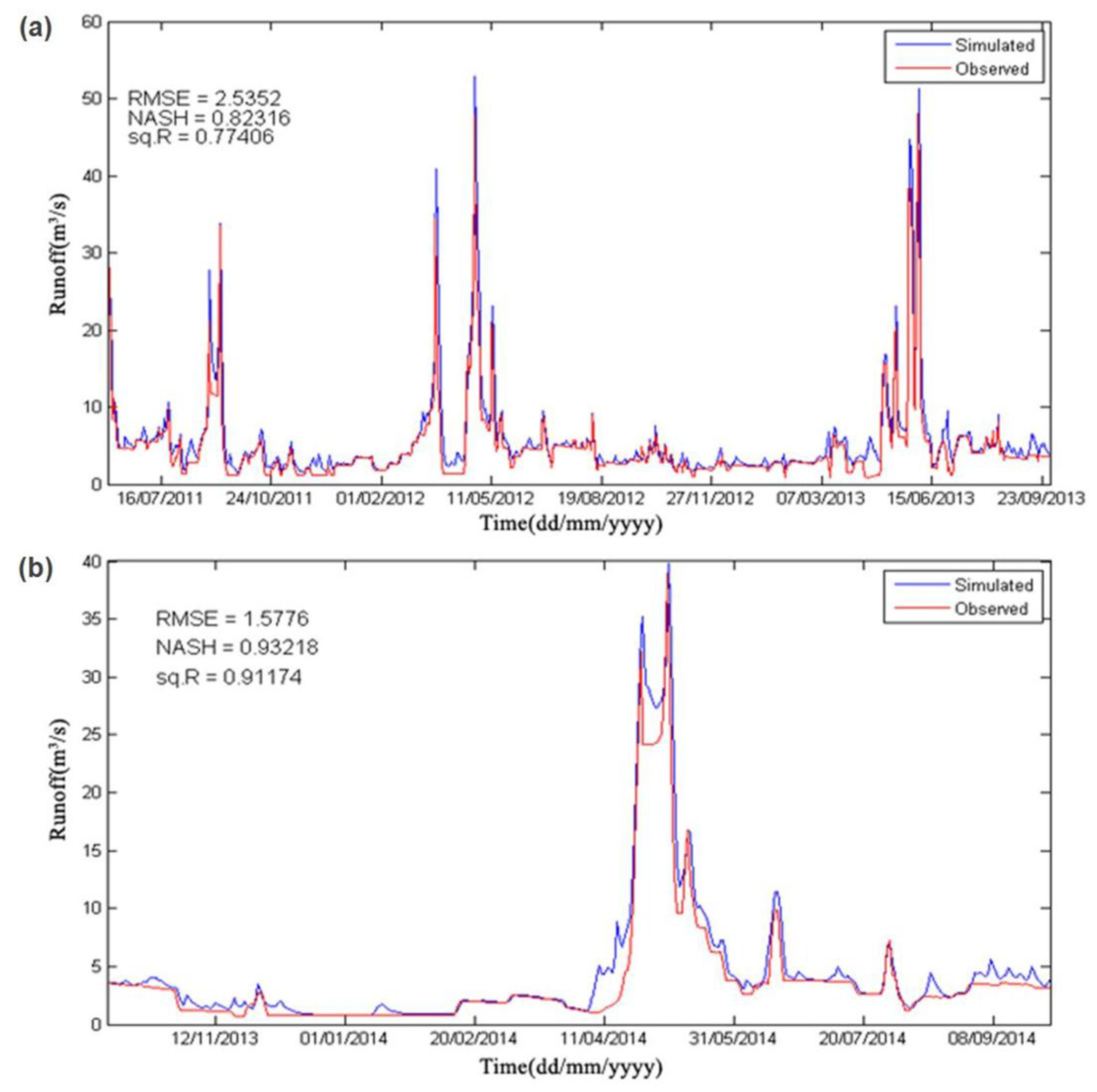
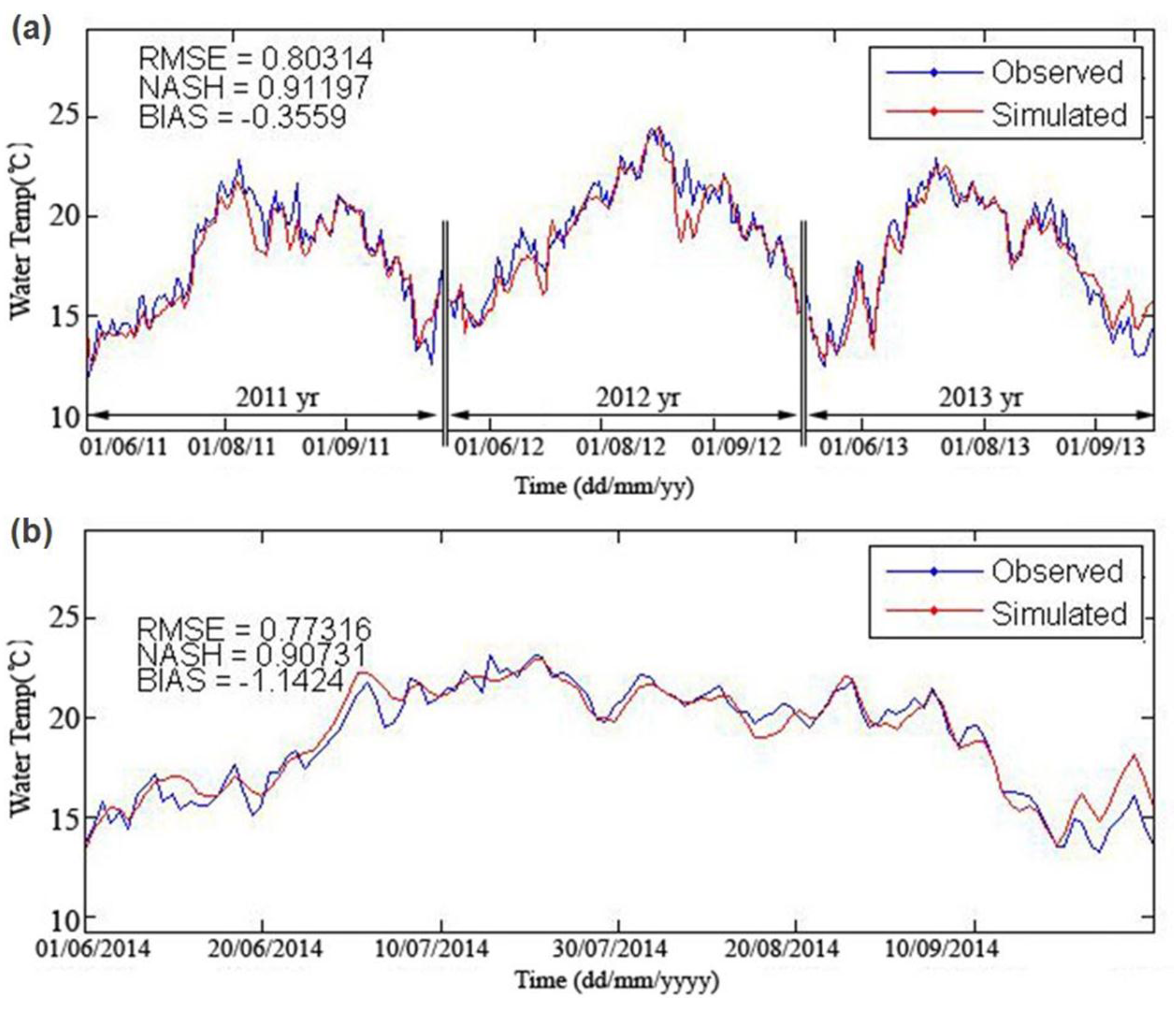
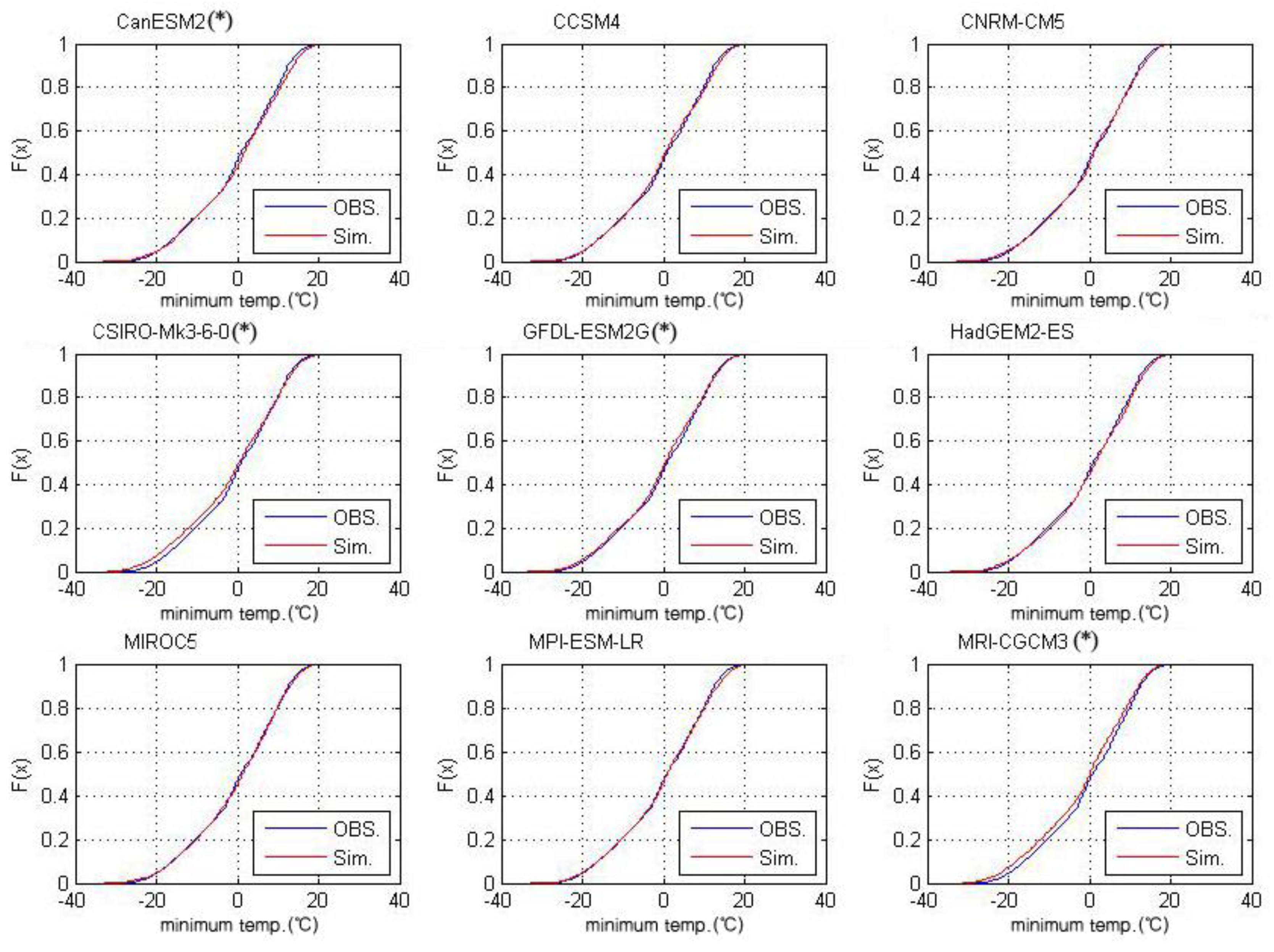
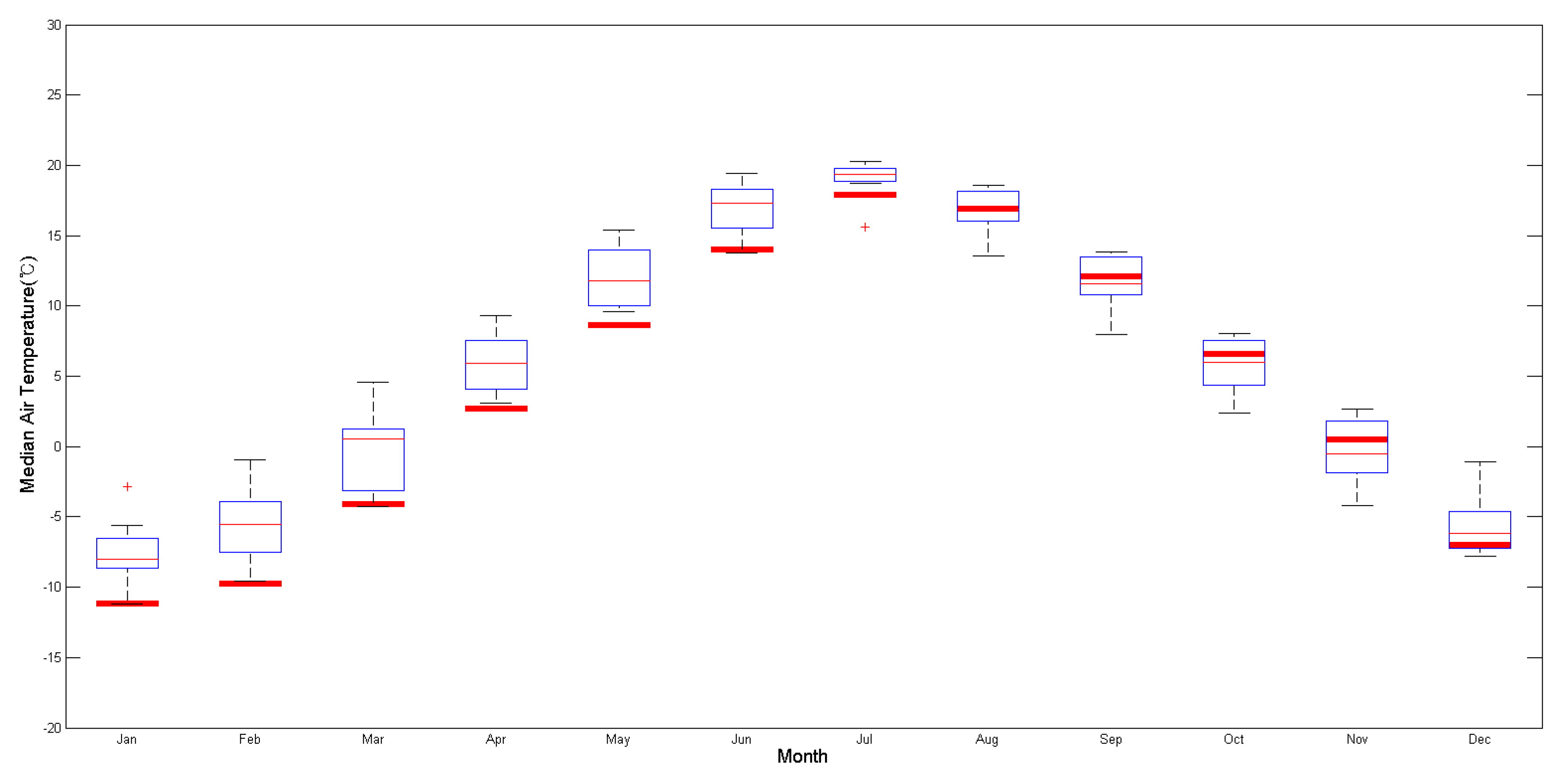
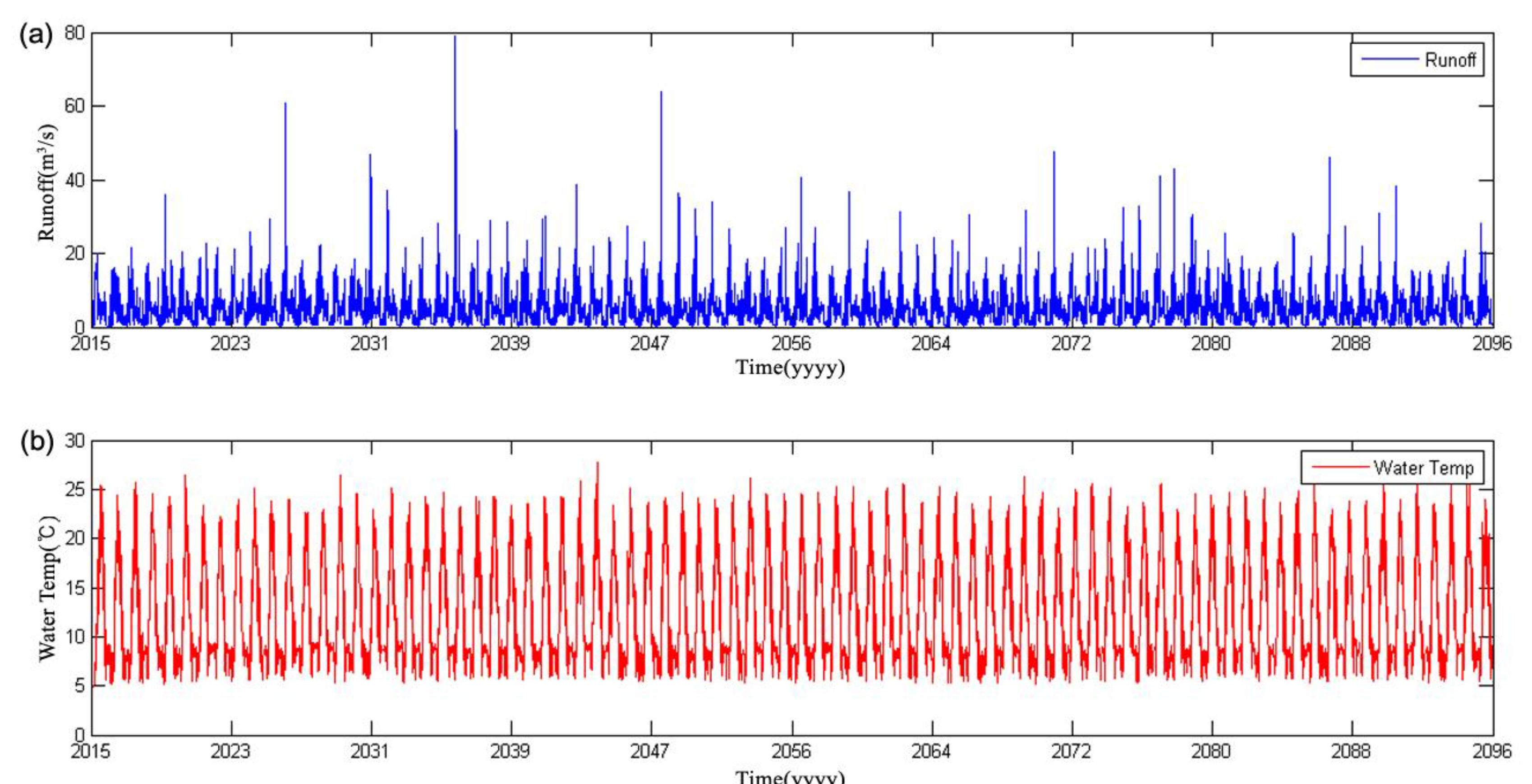
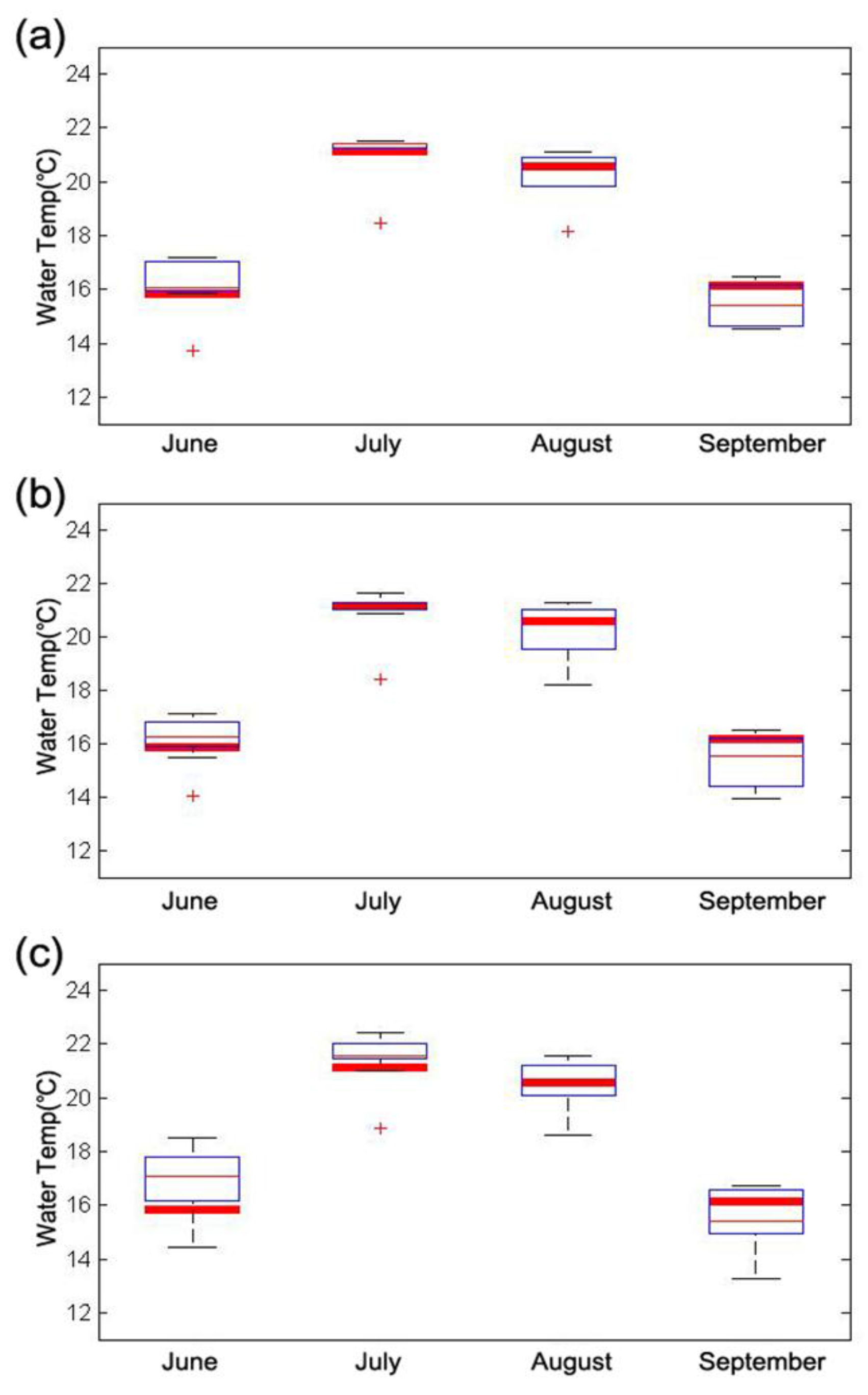
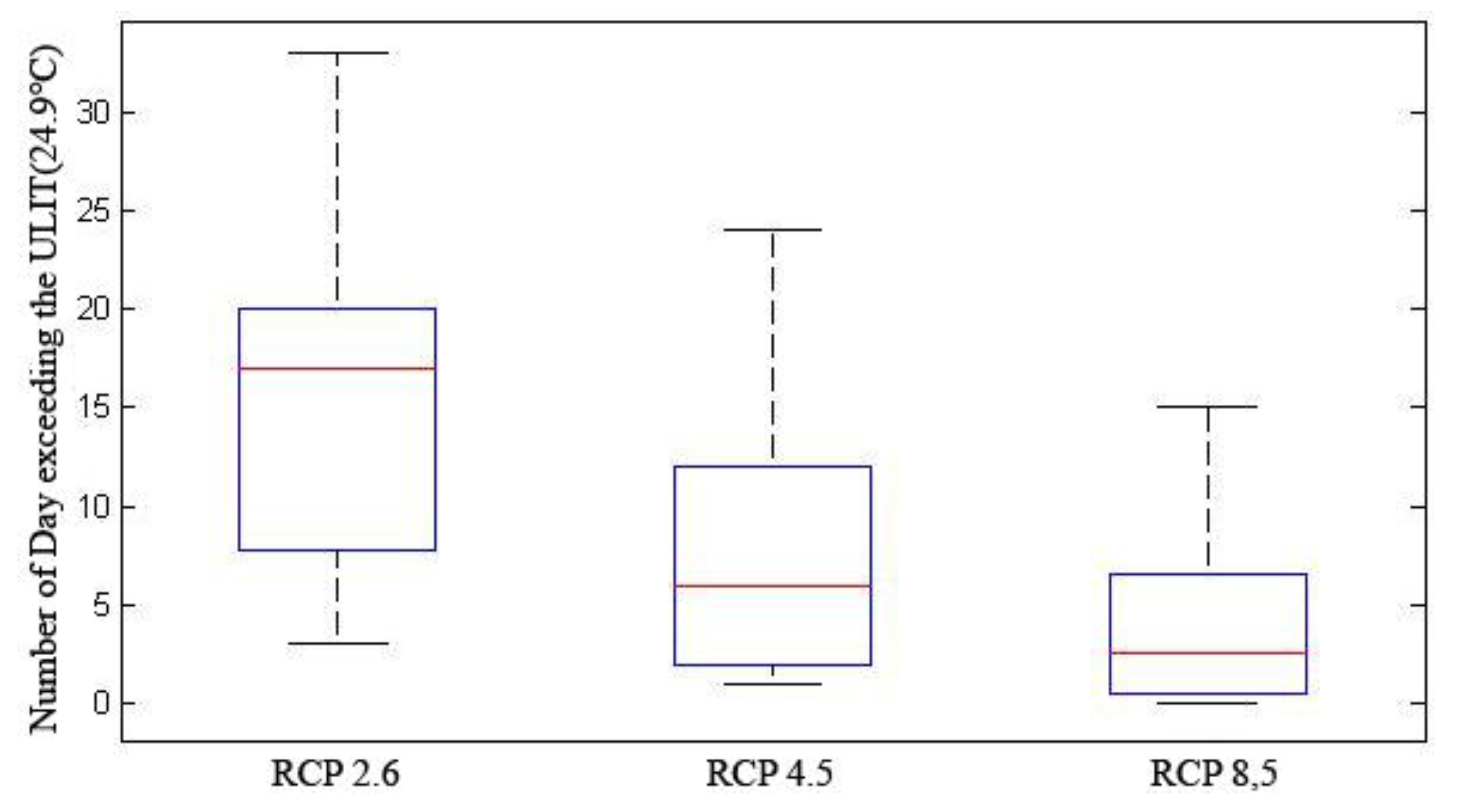
| Scenarios | Description | CO2 Concentration (ppm) | Global Warming until 2100 (Mean and Likely Range) |
|---|---|---|---|
| RCP 2.6 | Peak in radiative forcing at ~3 W/m2 before 2100 year and then decline | 490 | 1.0 (0.3–1.7) °C |
| RCP 4.5 | Stabilization without overshoot pathway to ~4.5 W/m2 at stabilization after 2100 year | 650 | 1.8 (1.1–2.6) °C |
| RCP 6.0 | Stabilization without overshoot pathway to ~6 W/m2 at stabilization after 2100 year | 850 | 2.2 (1.4–3.1) °C |
| RCP 8.5 | Rising radiative forcing pathway leading to 8.5 W/m2 by 2100 year | 1370 | 3.7 (2.6–4.8) °C |
| # | Modeling Center (or Group) | GCM | Model Expansion | Spatial Resolution |
|---|---|---|---|---|
| 1 | Max Planck Institute for Meteorology (MPI-M) | MPI-ESM-LR-r3 | Max Planck Institute Earth System Model, low resolution | 1.9° × 1.9° |
| 210 km× 210 km | ||||
| 2 | Institute for Numerical Mathematics | Inmcm4-r1 | Institute of Numerical Mathematics Coupled Model, version 4.0 | 2° × 1.5° |
| 220 km × 160 km | ||||
| 3 | Centre National de Recherches Météorologiques/Centre Européen de Recherche et Formation Avancée en Calcul Scientifique | CNRM-CM5-r1 | Centre National de Recherches M_et_eorologiques Coupled Global Climate Model, version 5.1 | 1.4° × 1.4° |
| 156 km × 156 km | ||||
| 4 | Commonwealth Scientific and Industrial Research Organization in collaboration with Queensland Climate Change Centre of Excellence | CSIRO-Mk3.6.0-r1 | Commonwealth Scientific and Industrial Research Organisation Mark, version 3.6.0 | 1.8° × 1.8° |
| 200 km × 200 km | ||||
| 5,6 | Met Office Hadley Centre (additional HadGEM2-ES realizations contributed by Instituto Nacional de Pesquisas Espaciais) | HadGEM2-ES-r1 | Hadley Centre Global Environment Model, version 2–Earth System | 1.875° × 1.25° |
| HadGEM2-CC-r1 | 208 km × 140 km | |||
| 7 | Canadian Centre for Climate Modelling and Analysis | CanESM2-r1 | Second Generation Canadian Earth System Model | 2.8° × 2.8° |
| 310 km × 310 km | ||||
| 8 | Meteorological Research Institute | MRI-CGCM3-r1 | Meteorological Research Institute Coupled Atmosphere–Ocean General Circulation Model, version 3 | 1.1° × 1.1° |
| 110 km × 110 km | ||||
| 9 | National Center for Atmospheric Research | CCSM4-r2 | Community Climate System Model, version 4 | 1.25° × 0.94° |
| 140 km × 105 km | ||||
| 10 | Atmosphere and Ocean Research Institute (The University of Tokyo), National Institute for Environmental Studies, and Japan Agency for Marine-Earth Science and Technology | MIROC5-r3 | Model for Interdisciplinary Research on Climate, version 5 | 1.4° × 1.4° |
| 156 km × 156 km | ||||
| 11 | CSIRO (Commonwealth Scientific and Industrial Research Organisation, Australia), and BOM (Bureau of Meteorology, Australia) | ACCESS1-0-r1 | Australian Community Climate and Earth-System Simulator, version 1.0 | 1.875° × 1.25° |
| 208 km × 140 km | ||||
| 12 | NOAA Geophysical Fluid Dynamics Laboratory | GFDL-ESM2G-r1 | Geophysical Fluid Dynamics Laboratory Earth System Model with Generalized Ocean Layer Dynamics (GOLD) component (ESM2G) | 2.5° × 2.0° |
| 280 km × 220 km |
| Climate Scenarios | Month | Median Temperature (Degrees °C) | |||
|---|---|---|---|---|---|
| OBS (2011–2014) | Sim. (2011–2014) | Next Decade (2016–2025) | Next 8 Decades (2016–2096) | ||
| RCP 2.6 | June | 15.83 | 15.42 | 16.07 (+0.2) | 16.04 (+0.2) |
| July | 21.12 | 20.82 | 21.39 (+0.3) | 21.50 (+0.4) | |
| Aug. | 20.54 | 20.26 | 20.55 | 20.60 | |
| Sep. | 16.13 | 16.45 | 15.42 (−0.7) | 15.96 (−0.2) | |
| RCP 4.5 | June | 15.83 | 15.42 | 16.28 (+0.4) | 16.03 (+0.2) |
| July | 21.12 | 20.82 | 21.17 | 20.91 (−0.2) | |
| Aug. | 20.54 | 20.26 | 20.57 | 20.55 | |
| Sep. | 16.13 | 16.45 | 15.52 (−0.6) | 15.45 (−0.7) | |
| RCP 8.5 | June | 15.83 | 15.42 | 17.06 (+1.2) | 16.50 (+0.7) |
| July | 21.12 | 20.82 | 21.59 (+0.5) | 21.05 | |
| Aug. | 20.54 | 20.26 | 20.66 (+0.1) | 20.08 (−0.5) | |
| Sep. | 16.13 | 16.45 | 15.40 (−0.7) | 14.97 (−1.1) | |
| Species | Optimal Temp. for Growth (°C) | Maximum Temp. Upper Tolerances (°C) * | Source |
|---|---|---|---|
| Rainbow trout (O. mykiss) | 15.0–19.0 | 24.0 * | [66] |
| Brook trout(S. fontinalis) | 14.4–16.0 | 24.9 | [65] |
© 2017 by the authors. Licensee MDPI, Basel, Switzerland. This article is an open access article distributed under the terms and conditions of the Creative Commons Attribution (CC BY) license (http://creativecommons.org/licenses/by/4.0/).
Share and Cite
Kwak, J.; St-Hilaire, A.; Chebana, F.; Kim, G. Summer Season Water Temperature Modeling under the Climate Change: Case Study for Fourchue River, Quebec, Canada. Water 2017, 9, 346. https://doi.org/10.3390/w9050346
Kwak J, St-Hilaire A, Chebana F, Kim G. Summer Season Water Temperature Modeling under the Climate Change: Case Study for Fourchue River, Quebec, Canada. Water. 2017; 9(5):346. https://doi.org/10.3390/w9050346
Chicago/Turabian StyleKwak, Jaewon, André St-Hilaire, Fateh Chebana, and Gilho Kim. 2017. "Summer Season Water Temperature Modeling under the Climate Change: Case Study for Fourchue River, Quebec, Canada" Water 9, no. 5: 346. https://doi.org/10.3390/w9050346







